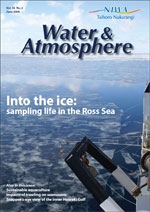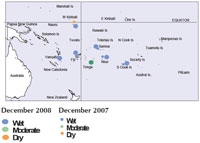PDF of this article (124 KB)


Fisheries ecologist Mark Morrison balances his desk job writing research proposals, reports, and journal articles with liberal doses of fieldwork in estuaries and coastal waters all around New Zealand. Mark gained his post-undergraduate degrees from the University of Auckland. For his research on rocky reef fish ecology and scallop ecology and enhancement, he was based at the University’s marine field station at Leigh.
Since 1996, when he joined the fisheries team at NIWA in Auckland, Mark’s research has encompassed several broad-scale surveys of coastal fisheries and habitat throughout the country. In this issue of Water & Atmosphere, he’s written about an extensive survey of the recreational snapper fishery in the inner Hauraki Gulf (see Snapper's-eye view of the inner Hauraki Gulf).
Mark’s days in the field can be quite varied, depending on the research objectives. We asked him to describe some of the fieldwork involved in an earlier project.
Tell us about your big coastal habitat survey.
For this project we sampled by dragging a small seine net in selected estuaries along the entire coastline of New Zealand,including Stewart Island. It’s taken us five or six years to do the whole country, and we’re still completing the data analysis. Our purpose was to see what small fish are living in the different habitats that are found in estuaries, from the lower channels or seagrass meadows at the mouth, up through the muddy reaches, and right up into the saltmarshes. We’re especially interested in small fish – juveniles in particular – and habitats such as seagrass beds, and in recording how these environments change around the country.
Logistics must be a major part of this kind of fieldwork.
We ran the surveys by working two sampling teams in convoy. Typically we had two-person teams and sometimes iwi, locals, or people from DOC helping us out. These teams would travel in a 4-wheel-drive vehicle, towing a small inflatable boat. We’d leapfrog down the country, with each team doing an estuary a day. We’d be on the road for a couple of weeks at a time, sometimes coming back to the same motel, sometimes checking into a new motel each night. We covered each area as efficiently as possible.
Did you sample every estuary?
We knew we couldn’t cover every estuary, so we picked our harbours for various reasons: sometimes because the estuary was typical, or unusual, or, sometimes because it was unspoiled by humans. Some of our estuaries were practically inaccessible and we’d end up dragging our boats over farmers’ fields, through gates, and down banks to get to the water. And sometimes we simply couldn’t get a boat into the site and had to seine the whole estuary on foot. The locals were especially good about helping us get into remote places and they also provided a rich local history. In all, we covered more than 70 of New Zealand’s 300-plus estuaries, including all the bigger ones.
Can you describe your schedule for a typical day?
Each day’s schedule was different, depending on how far we had to travel from the motel to the estuary and the timing of low tide for that day. In each esutary we aimed to drag our nets at eight sites ranging from the entrance to as far up as we could reach. To do this we planned on 5 to 6 hours on the water, split either side of low tide. With driving to our site, sampling, and then driving back (or else to our next accommodation), we worked 10 to 12 hours a day.
What happened to the samples you collected each day?
During the fieldwork, we identified, measured, and released the larger fish. We bagged the smaller stuff, carried it out, and froze it when we got back to the motel, and later shipped it back to our labin Auckland by refrigerated freight. In the field, we also recorded all sorts of environmental data about the water, the sediments, the plants, and so forth.
What’s the worst and the best your fieldwork can offer?
The absolute worst is the mud. In the shallows, the fine-mesh nets can occasionally fill up with it until we may end up hauling 200–300 kg of mud. And in some parts of the estuary we’re literally up to our waists in it. By the end of the day we look like the ‘Creature from the Black Lagoon’.
The really great parts about this fieldwork are the camaraderie and humour of the field crew and some of the amazing places we get to go to: remote, scenic, pristine, as close to a natural landscape as possible. It’s like you’re the first person there. And because we work throughout New Zealand, there’s a lot of variety – from Northland’s Rangaunu Harbour (which I think of as the hidden harbour, even though it’s a hundred square kilometres) to remote estuaries in Stewart Island.
Further reading
Morrison, M.; Carbines, G. (2004). Let sleeping fish lie. Water & Atmosphere 12(2): 21.
Morrison, M. (2005). Update on NIWA survey of fish communities in mangroves and seagrass meadows. Water & Atmosphere 13(2): 8.
Morrison, M.; Lowe, M.; Spong, K.; Rush, N. (2007). Comparing seagrass meadows across New Zealand. Water & Atmosphere 15(1): 16–17.
Morrison, M., Taylor, R., Walker, J., & Parsons, D. (2007). Marine recreation and coastal ecosystems. Water & Atmosphere 15(2): 20–21.
Morrison, M. (2008). Dancing in the dark: VIE tags and ASUs. Water & Atmosphere 16(1): 5.
Morrison, M.; Shankar, U.; Parsons, D.; Carbines, G.; Hartill, B. (2008). Snapper’s-eye view of the inner Hauraki Gulf. Water & Atmosphere 16(2): 18–21.
